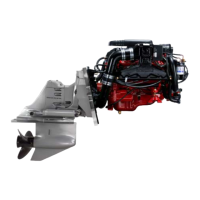VPA 7748089 English 09-2007 19
General Information
tions may allow extensive engine damage. Ensure the fuel system is
not contaminated with water before attempting to start engine.
Frequently check engine compartment for gasoline fumes and ex-
cessive water accumulation; water depth in bilge should be kept well
below flywheel housing.
Water entry through the intake or exhaust system is not considered
a defect in the engine and is excluded from coverage under the lim-
ited express warranty.
20-Hour Check
1. Change engine oil and oil filter.
2. Check power trim/tilt reservoir for proper fluid level.
3. Clean and inspect the ceramic filter located under the fuel
pump.
4. Check flame arrestor for proper mounting.
5. Start engine and check complete fuel system for leaks.
6. Lubricate steering cable ram with Volvo Penta grease P/N
828250. Check power steering pump reservoir for correct fluid
level on models equipped with power steering. Failure to prop-
erly lubricate the steering system could lead to loss of steering
control.
7. Check shift system for proper adjustment and operation. Verify
cable attachment clamp on pivot housing is fully seated and
secure. Inspect cable anchor and cotter pin at shift linkage on
stern drive for proper installation and free movement.
8. Inspect exhaust system. Tighten all hose clamps, and check for
leaks. Verify all clamps on exhaust and u-joint bellows are prop-
erly located and tightened.
9. Check tension on drive belt.
10. Check all engine mount screws, stern drive mounting nuts and
transom shield mounting nuts for tightness.
11. Check for any deficiencies, malfunctions, signs of abuse, etc.
Correction of any problems at this time will prevent the worsen-
ing of a minor problem and help ensure a trouble-free boating
season.
12. Check oil level in Sterndrive and add as necessary with GL-5
Synthetic Gear Lubricant or Mobilube 1 SHC Fully Synthetic
SAE 75W-90 (meeting or exceeding MIL-L-2105C or D, API
GL-4 or 5) gear lubricant.
13. Make sure engine can achieve maximum rated RPM with nor-
mal load.
Positive Closed Ventilation System
A malfunctioning crankcase ventilation system may be indicated by
loping or rough engine idle. Do not attempt to compensate for this
idle condition by disconnecting the crankcase ventilation system and
making adjustments. The removal of the crankcase ventilation sys-
tem from the engine will adversely affect fuel economy and engine
ventilation with resultant shortening of engine life. To determine

